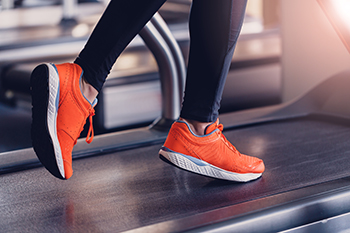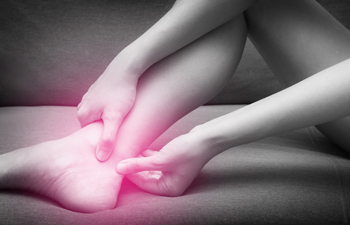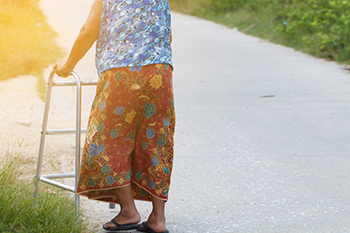Connect With Us
Blog
Items filtered by date: March 2023
Why Live with Pain and Numbness in Your Feet?
What Is a Tongue in Running Shoes?

When shopping for running shoes, it can be quite easy for an individual to become overwhelmed by all of the different styles and potential options. It can therefore be helpful for an individual to be familiar with and well-versed in the different technical terms for elements of a running shoe. One important part of a running shoe is known as the tongue of the shoe. This part of the shoe serves several important functions. For example, the tongue essentially protects the upper part of the foot from the laces. The tongue typically runs to the toe area. There are two different types of tongues in running shoes. First, gusseted tongues connect to both sides of the foot. By contrast, a burrito tongue only connects to one side of the foot. If you are someone that is looking to purchase a good pair of running shoes, it is highly recommended that you contact a podiatrist who can help you meet all of your running shoe needs.
If you are a runner, wearing the right running shoe is essential. For more information, contact Thi Pham, DPM from Foot Specialists of Tri-County. Our doctor can provide the care you need to keep you pain-free and on your feet.
Choosing the Right Running Shoe for Your Foot Type
To increase performance and avoid the risk of injury, it is important to choose the right running shoe based on your foot type. The general design of running shoes revolves around pronation, which is how the ankle rolls from outside to inside when the foot strikes the ground.
- Neutral runners are able to choose from a wide variety of shoes, including minimalist shoes or even going barefoot.
- Runners who overpronate, or experience an over-abundance of ankle rolling, should choose shoes that provide extra motion control and stability.
- Runners who underpronate, or supinate, have feet that have high arches and lack flexibility, preventing shock absorption. They require shoes with more flexibility and cushion.
If you have any questions please feel free to contact our offices located in Sulphur Springs, Winnsboro, and Pittsburg, TX . We offer the newest diagnostic and treatment technologies for all your foot and ankle needs.
Running Techniques

Many individuals all across the world choose to run regularly, either as a way to exercise or as a recreational activity. The biomechanics that are at play when an individual is engaged in running are significantly complex. For example, many different bones and muscles are working during a run to accomplish different objectives. One interesting aspect of foot biomechanics during running is that an individual might benefit if they use their feet to push down into the ground during a run. Although many runners might intuitively think they should use their feet to strike the ground and push off of the ground, a runner could potentially benefit from pushing down into the ground. This is because your body will require less energy to produce force and the manner in which your foot hits the ground could decrease one’s chance of injury. If you are someone that enjoys running, it is suggested that you contact a podiatrist to schedule an appointment.
If you have any concerns about your feet, contact Thi Pham, DPM from Foot Specialists of Tri-County. Our doctor can provide the care you need to keep you pain-free and on your feet.
Biomechanics in Podiatry
Podiatric biomechanics is a particular sector of specialty podiatry with licensed practitioners who are trained to diagnose and treat conditions affecting the foot, ankle and lower leg. Biomechanics deals with the forces that act against the body, causing an interference with the biological structures. It focuses on the movement of the ankle, the foot and the forces that interact with them.
A History of Biomechanics
- Biomechanics dates back to the BC era in Egypt where evidence of professional foot care has been recorded.
- In 1974, biomechanics gained a higher profile from the studies of Merton Root, who claimed that by changing or controlling the forces between the ankle and the foot, corrections or conditions could be implemented to gain strength and coordination in the area.
Modern technological improvements are based on past theories and therapeutic processes that provide a better understanding of podiatric concepts for biomechanics. Computers can provide accurate information about the forces and patterns of the feet and lower legs.
Understanding biomechanics of the feet can help improve and eliminate pain, stopping further stress to the foot.
If you have any questions please feel free to contact our offices located in Sulphur Springs, Winnsboro, and Pittsburg, TX . We offer the newest diagnostic and treatment technologies for all your foot and ankle needs.
Orthotics for Plantar Fasciitis

Plantar fasciitis is perhaps one of the most common conditions of the foot in which the band of tissue along the arch of the foot becomes inflamed. Heel pain can result from this inflammation. Many individuals will often want to treat their plantar fasciitis with the application of orthotics. Orthotics are shoe inserts that can treat conditions and/or correct deformities in the feet. Orthotics that treat plantar fasciitis can come in two different types. Namely, there are both hard and soft orthotics for plantar fasciitis. The soft orthotics used for plantar fasciitis arguably have more adjustability, and they also have softer padding. Hard orthotics for plantar fasciitis, on the other hand, are certainly more durable than soft orthotics. If you are someone that struggles with plantar fasciitis, it is suggested that you contact a podiatrist today for more information and possible treatment.
If you are having discomfort in your feet and would like to try orthotics, contact Thi Pham, DPM from Foot Specialists of Tri-County. Our doctor can provide the care you need to keep you pain-free and on your feet.
What Are Orthotics?
Orthotics are inserts you can place into your shoes to help with a variety of foot problems such as flat feet or foot pain. Orthotics provide relief and comfort for minor foot and heel pain but can’t correct serious biomechanical problems in your feet.
Over-the-Counter Inserts
Orthotics come in a wide variety of over-the-counter inserts that are used to treat foot pain, heel pain, and minor problems. For example, arch supports can be inserted into your shoes to help correct overarched or flat feet, while gel insoles are often used because they provide comfort and relief from foot and heel pain by alleviating pressure.
Prescription Orthotics
If over-the-counter inserts don’t work for you or if you have a more severe foot concern, it is possible to have your podiatrist prescribe custom orthotics. These high-quality inserts are designed to treat problems such as abnormal motion, plantar fasciitis, and severe forms of heel pain. They can even be used to help patients suffering from diabetes by treating foot ulcers and painful calluses and are usually molded to your feet individually, which allows them to provide full support and comfort.
If you are experiencing minor to severe foot or heel pain, it’s recommended to speak with your podiatrist about the possibilities of using orthotics. A podiatrist can determine which type of orthotic is right for you and allow you to take the first steps towards being pain-free.
If you have any questions please contact our offices located in Sulphur Springs, Winnsboro, and Pittsburg, TX . We offer the newest diagnostic and treatment technologies for all your foot and ankle needs.
Achilles Tendon Pain Often Requires Treatment

The Achilles tendon connects the muscles in the calf and lower leg to the heel bone. Like all tendons, this tendon is strong but not particularly flexible. If it is overstretched, it can become inflamed, which is tendonitis, or torn, and this is known as a rupture. When not taken care of, a condition called tendinosis can develop and chronic issues with the Achilles tendon will result. Achilles tendon injuries can cause mild to severe pain, burning, and stiffness in the Achilles tendon area or heel. These types of injuries are more common among athletes, especially runners, and those who play sports that require multiple starts, stops, and sudden changes of direction. Other groups of people who can be prone to getting Achilles tendon injuries are those who do not warm up prior to exercising, or those who increase the amount or intensity of their workouts suddenly. Additionally, patients who are obese, and those with prior health conditions, such as psoriasis or high blood pressure, may also be susceptible to incurring this type of injury. A rupture is a rare and serious Achilles tendon injury, and walking will usually be unbearable. If you have sustained an injury to your Achilles tendon, it is suggested that you see a podiatrist who can begin treatment as soon as possible, which may help to avoid further complications.
Achilles tendon injuries need immediate attention to avoid future complications. If you have any concerns, contact Thi Pham, DPM of Foot Specialists of Tri-County. Our doctor can provide the care you need to keep you pain-free and on your feet.
What Is the Achilles Tendon?
The Achilles tendon is a tendon that connects the lower leg muscles and calf to the heel of the foot. It is the strongest tendon in the human body and is essential for making movement possible. Because this tendon is such an integral part of the body, any injuries to it can create immense difficulties and should immediately be presented to a doctor.
What Are the Symptoms of an Achilles Tendon Injury?
There are various types of injuries that can affect the Achilles tendon. The two most common injuries are Achilles tendinitis and ruptures of the tendon.
Achilles Tendinitis Symptoms
- Inflammation
- Dull to severe pain
- Increased blood flow to the tendon
- Thickening of the tendon
Rupture Symptoms
- Extreme pain and swelling in the foot
- Total immobility
Treatment and Prevention
Achilles tendon injuries are diagnosed by a thorough physical evaluation, which can include an MRI. Treatment involves rest, physical therapy, and in some cases, surgery. However, various preventative measures can be taken to avoid these injuries, such as:
- Thorough stretching of the tendon before and after exercise
- Strengthening exercises like calf raises, squats, leg curls, leg extensions, leg raises, lunges, and leg presses
If you have any questions please feel free to contact our offices located in Sulphur Springs, Winnsboro, and Pittsburg, TX . We offer the newest diagnostic tools and technology to treat your foot and ankle needs.
Hospital Stays and Fall Prevention Techniques

The majority of hospitals implement fall prevention strategies. Studies suggest that falls may be overlooked, mainly because the patients are admitted for other reasons. If a fall occurs in the hospital, a promising recovery may take longer than expected. Patients may prefer to stay in bed as it may be safer than walking through corridors. However, mobility and strength can be increased when walking is done as often as possible. It is beneficial for hospitals to have employees learn how to protect patients from falling as each patient is unique. Some patients can fall as a result of mental status or from medications that put them at a higher risk for falls. Unanticipated falls can include people who suddenly experience a stroke or seizure, and different fall prevention protocols are often put in place. If you or a loved one would like to learn more fall prevention techniques, it is suggested that you reach out to a podiatrist who can provide you with helpful tips.
Preventing falls among the elderly is very important. If you are older and have fallen or fear that you are prone to falling, consult with Thi Pham, DPM from Foot Specialists of Tri-County. Our doctor will assess your condition and provide you with quality advice and care.
Every 11 seconds, an elderly American is being treated in an emergency room for a fall related injury. Falls are the leading cause of head and hip injuries for those 65 and older. Due to decreases in strength, balance, senses, and lack of awareness, elderly persons are very susceptible to falling. Thankfully, there are a number of things older persons can do to prevent falls.
How to Prevent Falls
Some effective methods that older persons can do to prevent falls include:
- Enrolling in strength and balance exercise program to increase balance and strength
- Periodically having your sight and hearing checked
- Discuss any medications you have with a doctor to see if it increases the risk of falling
- Clearing the house of falling hazards and installing devices like grab bars and railings
- Utilizing a walker or cane
- Wearing shoes that provide good support and cushioning
- Talking to family members about falling and increasing awareness
Falling can be a traumatic and embarrassing experience for elderly persons; this can make them less willing to leave the house, and less willing to talk to someone about their fears of falling. Doing such things, however, will increase the likelihood of tripping or losing one’s balance. Knowing the causes of falling and how to prevent them is the best way to mitigate the risk of serious injury.
If you have any questions, please feel free to contact our offices located in Sulphur Springs, Winnsboro, and Pittsburg, TX . We offer the newest diagnostic and treatment technologies for all your foot care needs.

